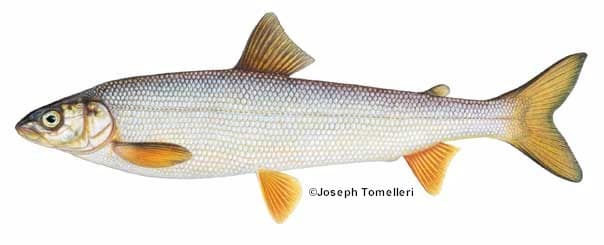Home → Fish & Wildlife → Fisheries → Species Information → Round Whitefish
Round Whitefish

Common Name: Round Whitefish
Other Names: Frostfish, Round Fish, Menominee Whitefish
Scientific Name: Prosopium cylindraceum
Origin: Native
Adult Size: Round whitefish are relatively long-lived with individuals up to 8 years of age common in most lake populations. Growth tends to be slower than that of lake whitefish and few individuals seen greater than 18 inches. Lengths usually range from 10-14 inches.
Identification: Round whitefish are noticeably cylindrical in body shape. They are dark brown on the back fading to silvery sides and silvery-white below. Pectoral and pelvic fins are typically light orange in color. Scales are large. An adipose fin, characteristic of members of the Salmonid family, is located on the back between the dorsal and caudal fins. The mouth is small and toothless as adults.
Diet: Almost primarily zooplankton and midge larvae, some crustaceans.
Fishing Tips: Round whitefish are rarely caught by anglers. They are difficult to catch due to their small mouths, typical small size (with some exceptions), and very small size of the items that make up their diet. They are not targeted in Maine to any extent, though there were historical fisheries for whitefish in the Kennebec River and large tributaries to the St. John River when abundant populations existed. Very occasionally, smelt anglers in northern Maine will catch one incidentally. Some people in northern Maine call them ‘river whitefish.’
Interesting Facts: Round whitefish are only found in larger, deep water lakes in Maine. There are also river populations, which were once abundant, but have declined considerably. Traditional springtime fisheries existed in several places, including the Little Black River in Allagash and Soldier Pond in Wallagrass. Most round whitefish populations spawn in large tributaries and outlet streams, but some lake spawning may occur as well.
Management: Round whitefish are managed under the same regulations as lake whitefish, though they are rarely caught by anglers. We have very little information on current round whitefish distribution, population status, and population trends. Due to limited resources, we’ve directed our research focus on lake whitefish. Our greatest management priority for round whitefish is increasing our basic understanding of the species and where it exists in Maine.